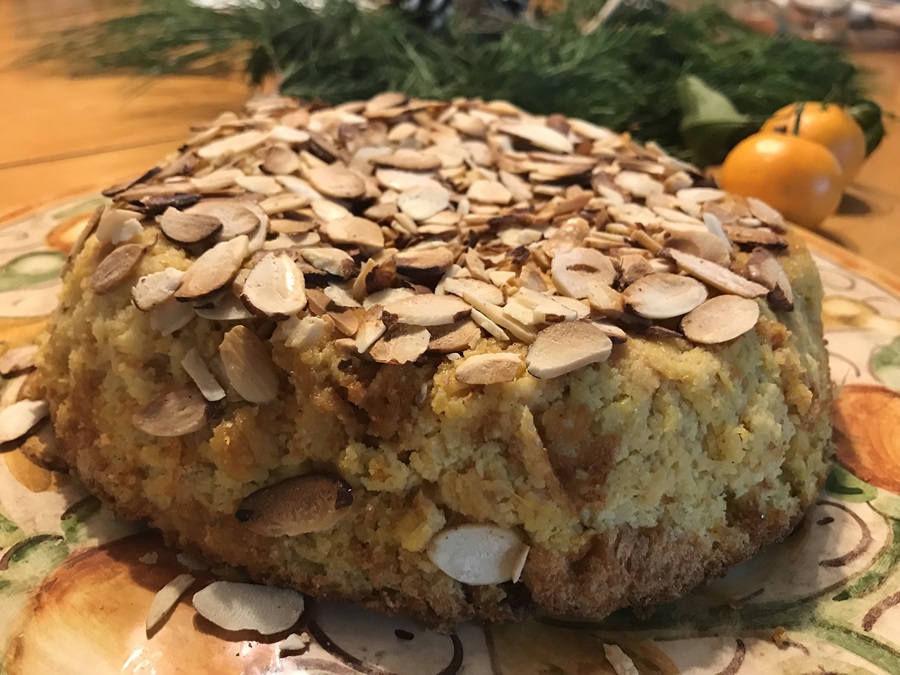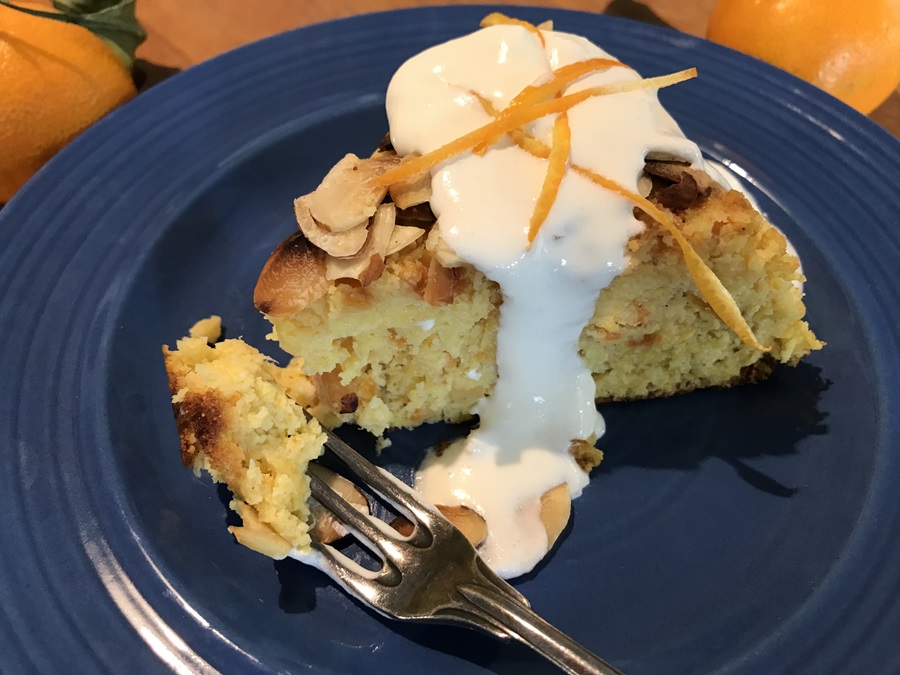As traditions often do, this one developed at our house out of necessity. It’s a celebratory cake made with oranges and almonds but without wheat flour, milk, butter, or leavening — you know how it is when loved ones converge. This is a cake that makes everyone happy. It tastes great, by the way — that’s a requirement we all agree on.
The cake’s origins trace to the pre-Renaissance, and I first encountered a rendition in an Italian cookbook. Some maintain that it developed in 14th-century Spain among Sephardic Jews and became a tradition for Passover, then spread across Europe when the Inquisition forced Jews to flee, many eastward across Europe and to the Mideast. The Moors had introduced oranges into Spain, and thus others claim that an orange-almond pastry arrived in Spain and Portugal from North Africa. In any case, the recipes, whatever their sources, mostly do not adhere to geopolitical boundaries but reflect regional agriculture, customs, trade routes, and migrations.

There is something magical about being able to enjoy these sunny flavors of the Mediterranean in the midst of a Cape Cod winter. Not only has this confection survived the test of historical time, it has seen us through many a Christmas, New Year’s Eve, and January blizzard. The cake sits there looking decorative through dinner, till the dishes are done and the fire is stoked. Then I bring it to the coffee table by the fireplace and serve it up. After visitors depart, we might play a family round or two of Scrabble, but on New Year’s Eve, only Hugo manages to stay up late enough to watch the festivities in Times Square and enjoy another serving of cake along with some cognac.
Intensely flavored and fragrant with orange, this confection is not too sweet. The texture is somewhere between cake and pudding, though it presents like a cake and has a decidedly old-world taste and aura. It is not a hurry-up kind of project, but you can easily prepare it in stages. Making it involves a few small projects — simmering whole oranges, toasting almonds, separating eggs — that can be done with a visiting friend or two in the kitchen. None of these steps is difficult; you can make it peacefully alone on a wintry afternoon.

Because the oranges are first cooked whole for almost an hour, then ground up, peel and all, organic oranges are preferable. If you have a choice, navel oranges are better than the average juice orange. The oranges, pureed, are combined with finely chopped almonds or almond flour. Whipped eggs are what give the cake its rise. It is helpful to bake this soft cake in a pan with a removable bottom, if you have one, for ease of releasing it from the pan when it’s done. In Italy, this is referred to as a sformato, a molded sweet or savory turned out on a plate. Less airy than a souffle, it won’t collapse.
All the recipes I’ve read for cakes like this one suggest this should keep well for several days and probably longer. It has never lasted long enough at our house for me to find out. Serve it at room temperature or slightly warm. It can be garnished with whipped almond cream and orange zest.
ORANGE-ALMOND CAKE
Makes one 8-inch cake
3 navel oranges, medium size
1¼ cups almonds (or almond flour)
6 eggs, separated
2/3 cup sugar
1/3 cup sliced almonds, toasted
For the optional garnishes
1 cup heavy cream
1 Tbsp. confectioners’ sugar
½ tsp. almond extract
Zest of 1 orange
- Wash the oranges in hot water, place them in a pot with enough water to cover, and bring to a boil. Cover the pot and simmer the oranges for 50 minutes.
- Preheat the oven to 400° F and lightly oil and flour a deep 8-inch cake pan. Use a springform if you have it.
- Remove oranges from the pan and let them cool briefly in cold water. Cut them in quarters and remove any seeds before pureeing them in a food processor or blender.
- Grind the whole almonds in a food processor, getting them as fine as possible without letting them become almond butter. Then stir together the ground almonds, or the almond flour, and the orange puree.
- Beat the egg whites until fluffy and set aside. Beat together the egg yolks and sugar until the mixture turns lemon-colored.
- Combine the orange-nut mixture with the egg yolk-sugar mixture and stir until well blended before gently folding in the beaten egg whites.
- Pour the batter into the pan and bake for about 60-65 minutes. It is done when a knife inserted into the center of the cake comes out clean.
- Let the cake cool for 10 minutes in the pan before turning it out. Scatter the toasted almonds over the top. For the optional garnishes, whip the cream, confectioners’ sugar, and almond extract together and serve it alongside or mound it on the cake with the orange zest on top.
